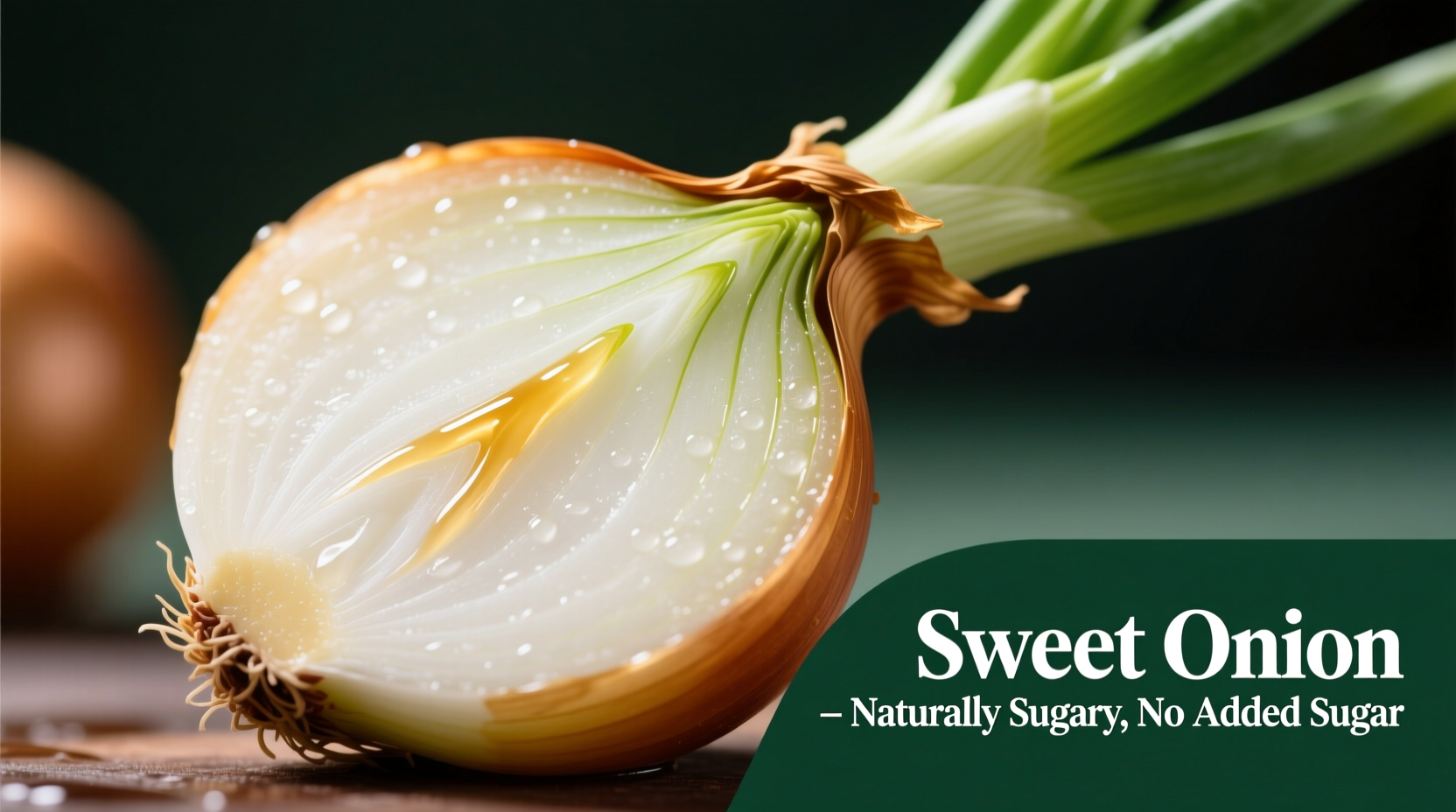What Makes an Onion "Sweet"?
Not all onions deliver that mild, almost sugary flavor profile we associate with sweet varieties. The sweetness comes down to two key factors: sulfur content and sugar concentration. Sweet onions grow in low-sulfur soil conditions, which reduces the pungent compounds that make regular onions tear-inducing. Simultaneously, they develop higher natural sugar levels—typically 5-6% compared to 3-4% in standard yellow onions.
According to agricultural research from the University of Georgia Cooperative Extension, soil composition directly impacts onion pungency. The sandy, low-sulfur soils of specific growing regions create the perfect conditions for sweet onion development. This scientific explanation helps home cooks understand why you can't simply substitute any onion when a recipe calls for sweet varieties.
Sweet Onion Varieties Compared
| Variety | Origin | Peak Season | Sugar Content | Best Culinary Uses |
|---|---|---|---|---|
| Vidalia | Georgia, USA | April-June | 5.4-6.0% | Raw applications, salads, sandwiches |
| Walla Walla | Washington, USA | June-August | 5.0-5.8% | Caramelizing, grilling, onion rings |
| Maui | Hawaii, USA | Year-round | 5.2-5.7% | Salsas, ceviche, raw preparations |
| Texas Sweet | Texas, USA | May-July | 4.8-5.5% | Grilling, roasting, sandwiches |
How Sweet Onions Developed: A Brief Timeline
The history of sweet onions reveals how regional agriculture shaped these distinctive varieties:
- 1898: Pete Pieri, a French soldier, brings sweet onion seeds to Walla Walla, Washington, planting the foundation for Walla Walla Sweets
- 1930s: Farmers in Vidalia, Georgia discover their sandy soil produces unusually mild onions
- 1945: The first Maui onion crop is harvested in Hawaii's volcanic soil
- 1986: Vidalia onions receive federal marketing order protection
- 2007: Walla Walla Sweet onions earn Protected Designation of Origin status
This agricultural evolution demonstrates how specific growing conditions created distinct regional varieties now protected by law. The USDA Agricultural Marketing Service maintains strict guidelines for what qualifies as Vidalia or Walla Walla onions, ensuring consumers receive authentic products.
When to Choose Sweet Onions Over Regular Varieties
Sweet onions shine in specific culinary applications but have limitations you should understand:
Best Uses for Sweet Onions
- Raw preparations where mild flavor is essential
- Caramelizing (they develop richer flavor faster)
- Grilling or roasting (their higher water content prevents burning)
- Delicate sauces and dressings
When to Avoid Sweet Onions
- Long-cooked stews (they break down too quickly)
- Recipes requiring sharp onion flavor
- When extended storage is needed (they spoil faster)
- Budget-conscious cooking (they're typically more expensive)
Professional chefs understand these context boundaries. As noted in culinary research from the Culinary Institute of America, sweet onions contain approximately 25% more water than yellow onions, which affects their performance in different cooking methods. This explains why they excel at caramelizing but disappear in long-simmered dishes.
How to Identify Genuine Sweet Onions
Not all onions labeled "sweet" are authentic regional varieties. Here's how to verify what you're buying:
- Vidalia onions must have the official logo and specify "Grown in Georgia" (only 20 Georgia counties can produce them)
- Walla Walla Sweets will indicate "Walla Walla Valley, Washington" on packaging
- Genuine sweet onions feel heavy for their size with tight, dry skins
- Avoid onions with green sprouts or soft spots, which indicate age

Storage Tips for Maximum Freshness
Sweet onions have a shorter shelf life than regular onions due to their higher water content. Follow these storage guidelines:
- Store in a cool, dark place with good air circulation
- Never refrigerate whole sweet onions (causes texture deterioration)
- Use within 2-3 weeks of purchase (versus 2-3 months for yellow onions)
- Once cut, store in airtight container in refrigerator for up to 7 days
Understanding these practical storage requirements helps prevent waste and ensures you enjoy sweet onions at their peak flavor. The FDA Food Code recommends keeping all onions in well-ventilated containers away from direct sunlight to maximize freshness.
Common Sweet Onion Misconceptions
Several myths persist about sweet onions that affect how home cooks use them:
- Myth: All white onions are sweet onions
Fact: White onions typically have sharper flavor than yellow onions - Myth: Sweet onions don't make you cry
Fact: They produce fewer tears but still contain lachrymatory compounds - Myth: "Sweet" is just a marketing term
Fact: Specific varieties meet strict sugar and pungency standards - Myth: You can make any onion sweet by soaking in water
Fact: This only removes surface compounds temporarily
Frequently Asked Questions
What's the main difference between Vidalia and Walla Walla onions?
Vidalia onions have a slightly higher sugar content (5.4-6.0%) and are harvested earlier in the season (April-June), while Walla Walla onions have a more pronounced floral note and peak from June-August. Vidalias must be grown in specific Georgia counties, while Walla Wallas come exclusively from Washington's Walla Walla Valley.
Can I substitute sweet onions for yellow onions in recipes?
You can substitute sweet onions for yellow onions in raw applications or quick-cooking dishes, but avoid substituting in long-simmered recipes. Sweet onions have higher water content and break down faster. For every 1 cup of yellow onion, use ¾ cup sweet onion to prevent overwhelming the dish with sweetness.
Why are sweet onions more expensive than regular onions?
Sweet onions cost more due to their limited growing regions, shorter harvest windows, higher water content (making them heavier to transport), and shorter shelf life. The protected designation status for varieties like Vidalia and Walla Walla also limits supply to specific geographic areas, contributing to higher prices.
Do sweet onions have the same health benefits as regular onions?
Sweet onions contain slightly fewer antioxidants than yellow onions due to their lower sulfur compounds, but they still provide significant vitamin C, B6, and potassium. All onion varieties offer health benefits including anti-inflammatory properties and cardiovascular support, though the specific phytochemical profile varies between types.











 浙公网安备
33010002000092号
浙公网安备
33010002000092号 浙B2-20120091-4
浙B2-20120091-4